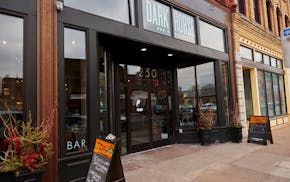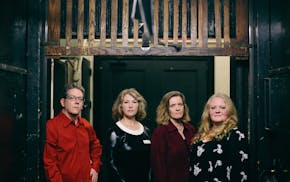Living in a house in the middle of a public park is not a common scenario. Yet that's the reality for Kendra Bangoura and her husband, Al Bangoura, for whom a stroll through the park literally entails walking out their front door.
The Bangouras are in the rare situation of living in the only residence allowed on Minneapolis parks system land. The two have lived in the storied house in Lyndale Farmstead Park in south Minneapolis since Al was appointed Minneapolis Parks superintendent in 2019, where he oversees 570 full-time and 1,170 temporary employees and manages a $125 million budget. Much like the White House or the Minnesota Governor's Residence, a house is a perk of the top job — though the Bangouras pay $2,250 monthly in rent that includes utilities, according to the Minneapolis Park and Recreation Board.
A few times a year, the house opens for public tours. Most recently, it rolled out the welcome mat to Doors Open Minneapolis in which dozens of visitors walked through.
However, the house built in 1910 for and named after Theodore Wirth, the park system's famed second superintendent, is severely outdated and needs repair and renovation, according to Kendra.
She along with others tied to its history — Mark Ruhe, who lived in the house for 12 years when his father was a park superintendent, and Dana Wirth Sparks, Theodore Wirth's great-granddaughter — are spearheading renovation efforts. They've formed the nonprofit Stewards of the Park through which they hope to raise around $2.5 million for upgrades to the beloved house referred to as Theodore Wirth Home.
For example, the six-bedroom craftsman-style house has one full bathroom. A half-bathroom was semi-converted into a coat closet since the family was warned not to flush its toilet due to plumbing issues when they moved in, she said. Plus, updating the basement, used decades ago for parks administration, could potentially provide a gathering space for groups and a renovated kitchen would make hosting easier.
"Bringing this house into the 21st century is part of what this is all about," Ruhe said. "We joke about the house having one full bath in a five-level home. That's not exactly current standards in the real estate industry."
Inside moves
So what's it like to live in the storied residence while parkgoers picnic on the grass in the summertime and skate on the ice rink during winters?
Inside is a mix of historic and modern styles along with personal sentiments from the Bangoura family. There are pictures of their son, who is a student at the University of Minnesota, and African relics, amid original built-in bookcases and brightly colored glass on cabinetry in the living room.
"I have a very modern, midcentury aesthetic. I love mixing old and new," Kendra said. "And Al has gotten a lot of African artifacts so it was trying to mix my midcentury — a little bit more modern — with this historic home and then his African stuff — it took a while to get the feel."
That's because it took some time for the family to settle in and truly feel like it was their own — two years to be exact, she said. It was five times bigger than their old home in the Longfellow neighborhood.
The foyer has a grand staircase leading up to several rooms on the second floor. The dining room has a long table, perfect for hosting, and the basement, which at one point housed park operations, has Theodore Wirth's original wooden desk in pristine condition. A hidden cabinet in the living room was used during the Prohibition era to hide booze.
The back porch overlooks the nearby cemetery with light streaming in. Now a four-season porch, it was once a place where the boys of the house would show what they were made of.
"My grandpa said that the boys always slept out there in the summer but they also loved sleeping out there in the winter just to prove how tough they were," Wirth Sparks said.
A community gem
For years the city was unsure what to do with the property — once called a dump and left vacant for long periods. But keeping it empty would tear a hole in the community, Ruhe said.
Ruhe recalled kids ringing the doorbell for help with bloody noses while sledding down the hill and one time he and a friend stopped a woman from getting assaulted. His family also helped drunk men who had fallen into the snow, unconscious.
"Absence of people do create problems," he said. "Having a family living here — even just for no other reason than picking up the phone and calling police or helping neighbors — it's a responsibility."
After riots broke out following George Floyd's death at the hands of a Minneapolis police officer, scores of unsheltered people took to the park in tents, becoming temporary neighbors to the Bangoura family.
"We got this really nice card from a woman living in the encampment and she said, 'It gave me an opportunity to get on my feet,'" Kendra said. And after the park board at the time extended the period the encampment could stay in the park the woman was able to save enough money to find a stable place to live.
"She sent a note to Al and thanked him for that," she said. "I just thought, 'Wow.' "
The Bangouras say that living on parkland comes with quirks and perks.
The couple don't blame onlookers curious to see what the historic home looks like, even though they get the occasional person looking through their windows, Kendra said.
But sights they see more often are kids sledding down the hills, tight-ropers balancing between two trees or couples picnicking.
"We pinch ourselves every time we wake up in the morning," Kendra said. "You look out almost every single window here, you see green or some view and you feel this sense of responsibility of this awesome park system."

The 5 best things our food writers ate this week

A Minnesota field guide to snow shovels: Which one's best?

Summer Camp Guide: Find your best ones here

Lowertown St. Paul losing another restaurant as Dark Horse announces closing

